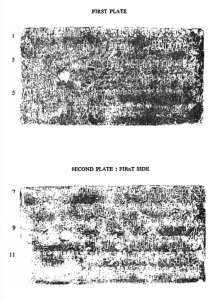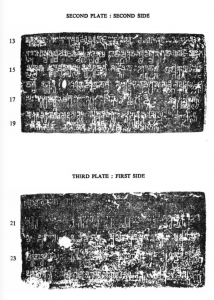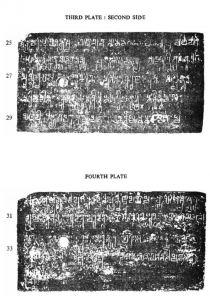


This set of four copper plates was discovered during the ploughing of a field in the village of Māṇḍhaḷ in 1982. The plates date to the 5th year of Rudrasena II’s reign and record the donation of four villages, Selludraha, Achchhabhallikā, Suragrāmakā and Aragrāmakā, which were used as a Brāhmaṇa settlement, occupied by Brāhmaṇa’s from different sects. The charter was written by Senāpati Vibhīshaṇa for Rudrasena II, and is stated to have been issued by the king himself following a command from Viṣṇu. Records so far do not specify in which field the copper plates were discovered.
| Metadata | |
|---|---|
| Inscription ID | IN00182 |
| Title | Mandhal Charter of Rudrasena II, Year 5 |
| Alternative titles | Mandhal Plates of Rudrasena II, Year 5 |
| Parent Object | OB00169 |
| Related Inscriptions | |
| Responsibility | |
| Author | Dániel Balogh |
| Print edition recorded by | Dániel Balogh |
| Source encoded | |
| Digitally edited by | |
| Edition improved by | Dániel Balogh |
| Authority for | Own research. |
| Metadata recorded by | Dániel Balogh |
| Authority for metadata | |
| Metadata improved by | |
| Authoriy for improved | |
| Language | संस्कृतम् |
| Reigning monarch | Rudrasena II |
| Commissioner | |
| Topic | donation of four villages, Selludraha, Achchhabhallikā, Suragrāmakā and Aragrāmakā, which were used as a Brāhmaṇa settlement, occupied by various Brāhmaṇa’s from different sects |
| Date: | |
| Min | 375 |
| Max | 405 |
| Comment | Basis of dating: approximate reign of Rudrasena II. |
| Hand | |
| Letter size | 0.8 |
| Description | southern box-headed |
| Layout | |
| Campus: | |
| Width | 19 |
| Height | 10.5 |
| Description | 34 lines of writing in total (of which one is actually a marginal addition and one, the last, is very brief), with 5-6 lines per page (7 including the marginal insertion on 2 verso). Generally in good condition, but the first plate was damaged by fire in the finders' attempt to cleanse it. Campus and character size are estimates. |
| Decoration | None. |
| Bibliography | |
| References | First reported in IAR 1981-82: 81 (No. 31). Edited in Shastri Gupta 1997. Discussed in Shastri 1987: 46-48 and Shastri 1997: 85-88. |
| Add to bibliography | |
| Misc notes | Mondasvāmin is the post-humous epithet of queen Prabhāvatiguptā, see Hans Bakker, The Vākāṭakas: An Essay in Hindu Iconology, p. 19, p. 120. The metamorphosis is explained with examples in Willis, The Archaeology of Hindu Ritual, p. 137 and pp. 140-41. |